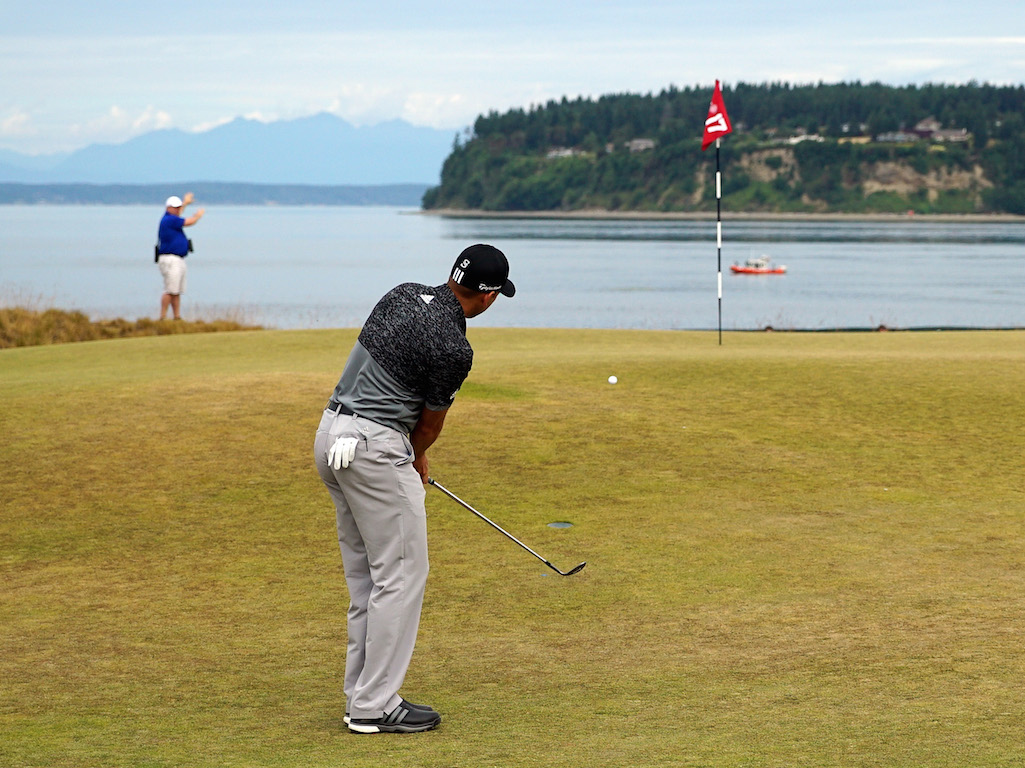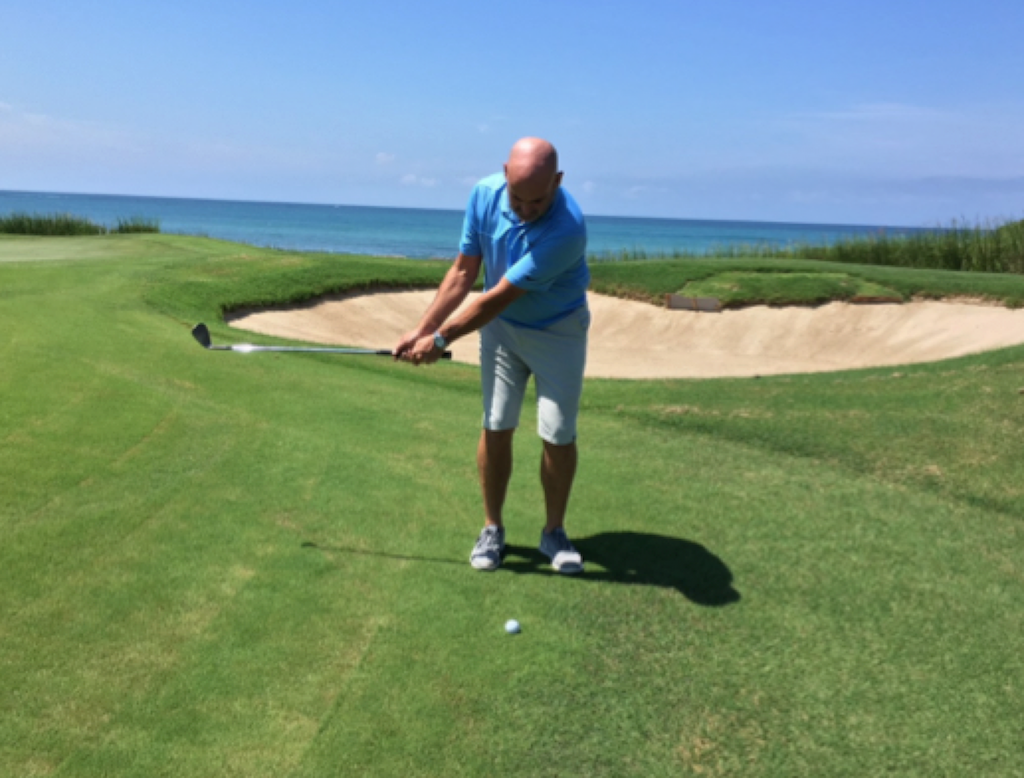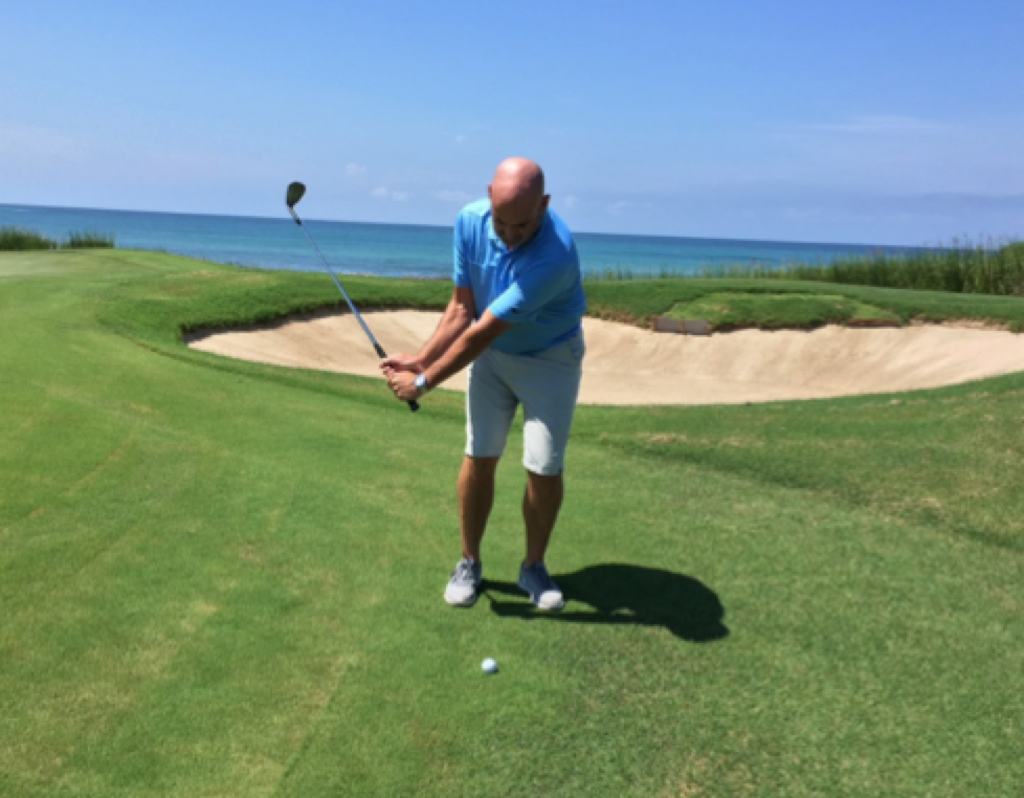Instruction
“Float Loading”: The secret to hitting the one-hop-and-stop wedge shot

One of the most impressive and effective shots in professional golf is the 20-30 yard wedge shot that comes off low and hot, skips once or twice, and then comes to a quick halt. Fans love this shot, as it always evokes a cheer from the crowd, and amateurs want to hit this shot.
Below, I’m going to teach you how to hit that low-spinning, one-hop-and-stop shot.
For the sake of this article we’ll assume that the conditions are right for hitting this type of shot: you have a clean and tight lie, your wedge is clean and free of debris, the ball you are playing is one that is designed to spin, and you have a green that is capable of receiving this type of shot. If you have these things you have a much better chance of stopping the ball like the professionals on Tour.
Now let’s examine the photos of how this is done…
1) Address: Weight forward

At address, you can see that my spine is centered, the ball is in the center of my stance, and my hands and weight are forward. These things set me up for a downward angle of attack with a forward leaning clubshaft. These two components will add spin (up to a point) and help the ball stop quicker.
2) No-hinge backswing

On the way back I have not hinged my wrists very much, or even at all, because they will “re-cock” on the way down to increase the bend in my rear wrist leaning the shaft forward during impact.
3) Transitional lag

Here is the secret to the shot: the angle between the lead arm and the shaft is decreased on the way down. This transitional lag of the clubshaft will cause the rear wrist to bend more on the way down.
The secret to this move is a slow and soft change of direction so you can “feel” the clubhead lagging behind you. The wrists must feel relaxed. Homer Kelley in his book, The Golfing Machine, called this “float loading,” and that’s just what the club feels like in transition.
4) Forward-leaning impact

At impact, depending on how much transitional lag you added in the above step, you will see a forward leaning clubshaft here. The amount of lean will determine the dynamic loft you have on your wedge at impact and this will cause the ball to launch lower.
One thing to note here: our goal is to just brush the grass after the ball with a forward leaning clubshaft, not dig a trench. If the angle of attack is too much downward, then you might have some trouble getting the ball to stop as quickly.
Remember, this is something you must practice! It’s not a shot that you will play every time, but it’s a great shot to play when you need some extra spin around the green. Float loading is a great technique, but only if you work at it!
- LIKE147
- LEGIT17
- WOW6
- LOL7
- IDHT2
- FLOP10
- OB6
- SHANK93
Instruction
Clement: Laid-off or perfect fade? Across-the-line or perfect draw?

Some call the image on the left laid off, but if you are hitting a fade, this could be a perfect backswing for it! Same for across the line for a draw! Stop racking your brain with perceived mistakes and simply match backswing to shot shape!
- LIKE0
- LEGIT0
- WOW0
- LOL0
- IDHT0
- FLOP0
- OB0
- SHANK0
Instruction
The Wedge Guy: The easiest-to-learn golf basic

My golf learning began with this simple fact – if you don’t have a fundamentally sound hold on the golf club, it is practically impossible for your body to execute a fundamentally sound golf swing. I’m still a big believer that the golf swing is much easier to execute if you begin with the proper hold on the club.
As you might imagine, I come into contact with hundreds of golfers of all skill levels. And it is very rare to see a good player with a bad hold on the golf club. There are some exceptions, for sure, but they are very few and very far between, and they typically have beat so many balls with their poor grip that they’ve found a way to work around it.
The reality of biophysics is that the body moves only in certain ways – and the particulars of the way you hold the golf club can totally prevent a sound swing motion that allows the club to release properly through the impact zone. The wonderful thing is that anyone can learn how to put a fundamentally sound hold on the golf club, and you can practice it anywhere your hands are not otherwise engaged, like watching TV or just sitting and relaxing.
Whether you prefer an overlap, interlock or full-finger (not baseball!) grip on the club, the same fundamentals apply. Here are the major grip faults I see most often, in the order of the frequency:
Mis-aligned hands
By this I mean that the palms of the two hands are not parallel to each other. Too many golfers have a weak left hand and strong right, or vice versa. The easiest way to learn how to hold the club with your palms aligned properly is to grip a plain wooden ruler or yardstick. It forces the hands to align properly and shows you how that feels. If you grip and re-grip a yardstick several times, then grip a club, you’ll see that the learning curve is almost immediate.
The position of the grip in the upper/left hand
I also observe many golfers who have the butt of the grip too far into the heel pad of the upper hand (the left hand for right-handed players). It’s amazing how much easier it is to release the club through the ball if even 1/4-1/2″ of the butt is beyond the left heel pad. Try this yourself to see what I mean. Swing the club freely with just your left hand and notice the difference in its release from when you hold it at the end of the grip, versus gripping down even a half inch.
To help you really understand how this works, go to the range and hit shots with your five-iron gripped down a full inch to make the club the same length as your seven-iron. You will probably see an amazing shot shape difference, and likely not see as much distance loss as you would expect.
Too much lower (right) hand on the club
It seems like almost all golfers of 8-10 handicap or higher have the club too far into the palm of the lower hand, because that feels “good” if you are trying to control the path of the clubhead to the ball. But the golf swing is not an effort to hit at the ball – it is a swing of the club. The proper hold on the club has the grip underneath the pad at the base of the fingers. This will likely feel “weak” to you — like you cannot control the club like that. EXACTLY. You should not be trying to control the club with your lower/master hand.
Gripping too tightly
Nearly all golfers hold the club too tightly, which tenses up the forearms and prevents a proper release of the club through impact. In order for the club to move back and through properly, you must feel that the club is controlled by the last three fingers of the upper hand, and the middle two fingers of the lower hand. If you engage your thumbs and forefingers in “holding” the club, the result will almost always be a grip that is too tight. Try this for yourself. Hold the club in your upper hand only, and squeeze firmly with just the last three fingers, with the forefinger and thumb off the club entirely. You have good control, but your forearms are not tense. Then begin to squeeze down with your thumb and forefinger and observe the tensing of the entire forearm. This is the way we are made, so the key to preventing tenseness in the arms is to hold the club very lightly with the “pinchers” — the thumbs and forefingers.
So, those are what I believe are the four fundamentals of a good grip. Anyone can learn them in their home or office very quickly. There is no easier way to improve your ball striking consistency and add distance than giving more attention to the way you hold the golf club.
More from the Wedge Guy
- The Wedge Guy: Golf mastery begins with your wedge game
- The Wedge Guy: Why golf is 20 times harder than brain surgery
- The Wedge Guy: Musings on the golf ball rollback
- LIKE86
- LEGIT13
- WOW6
- LOL1
- IDHT0
- FLOP4
- OB1
- SHANK8
Instruction
Clement: Stop ripping off your swing with this drill!

Not the dreaded headcover under the armpit drill! As if your body is defective and can’t function by itself! Have you seen how incredible the human machine is with all the incredible feats of agility all kinds of athletes are accomplishing? You think your body is so defective (the good Lord is laughing his head off at you) that it needs a headcover tucked under the armpit so you can swing like T-Rex?
- LIKE0
- LEGIT2
- WOW2
- LOL0
- IDHT0
- FLOP0
- OB0
- SHANK2
-

 19th Hole2 weeks ago
19th Hole2 weeks agoDave Portnoy places monstrous outright bet for the 2024 Masters
-

 19th Hole2 weeks ago
19th Hole2 weeks agoTiger Woods arrives at 2024 Masters equipped with a putter that may surprise you
-

 19th Hole2 days ago
19th Hole2 days agoJustin Thomas on the equipment choice of Scottie Scheffler that he thinks is ‘weird’
-

 19th Hole2 days ago
19th Hole2 days ago‘Absolutely crazy’ – Major champ lays into Patrick Cantlay over his decision on final hole of RBC Heritage
-

 19th Hole3 weeks ago
19th Hole3 weeks agoReport: Tiger Woods has ‘eliminated sex’ in preparation for the 2024 Masters
-

 19th Hole1 week ago
19th Hole1 week agoTwo star names reportedly blanked Jon Rahm all week at the Masters
-

 19th Hole1 week ago
19th Hole1 week agoReport: LIV Golf identifies latest star name they hope to sign to breakaway tour
-

 19th Hole1 week ago
19th Hole1 week agoNeal Shipley presser ends in awkward fashion after reporter claims Tiger handed him note on 8th fairway





















Homer Doyle
Nov 8, 2018 at 9:14 pm
Funny, I try to feel the shaft leaning BACK to hit a low shot with spin and float loading would not be in my 24
geohogan
Oct 28, 2018 at 8:41 pm
COR determines spin. To adjust ball flight, external focus is on which groove to impact the ball.
The higher the groove, the lower the flight(higher the spin)
Hands forward is effect of proper external intention.
Ref. The Hogan Manual of Human Performance: GOLF, 1992.
Chuck Daniels
Nov 8, 2018 at 9:16 pm
LOWER the groove the LOWER the flight and HIGHER the spin.
The LOWER the loft the more SOLID it feels and a spinner is not solid. We could cut a balata ball doing it one time.
Obee
Oct 25, 2018 at 10:03 am
What club are you playing that with, Tom? In my experience, the low-flying, high-spinning “put on the brakes after a bounce or two” shot is usually hit with a LW or SW. Looks like you are hitting a PW or GW there?
Dshafe
Oct 25, 2018 at 9:29 pm
dave you dont have the swing speed for this shot
koober
Oct 24, 2018 at 8:24 pm
So I guess I’ll be the token commenter for whom this method of chipping works. I had no problem with the term or the explanation. Like the article states, one must practice this, a lot. Probably won’t work as well for higher handicappers, because it does require a higher degree of proficiency to pull off successfully. Props for owning up to the typo, Ben. Mistakes. We all make ’em.
Tom
Oct 24, 2018 at 7:56 pm
I executed a “Float Landing” this morning after my second cup of coffee.
d
Oct 24, 2018 at 3:42 pm
Why did Homer Kelly call this “Float Loading”? According to Websters, Float (verb) is defined as “…rest or move on or near the surface of a liquid without sinking.”
Nick
Oct 23, 2018 at 11:57 pm
Can you explain what green conditions are necessary to get this type of action?
Yep
Oct 24, 2018 at 2:28 am
All American courses that have no rough, and that’s all of them, and are mowed so people like Phil can play there.
Joe
Oct 24, 2018 at 6:22 am
Congratulations on the ignorant, uninformed internet post of the day
Alex
Oct 23, 2018 at 2:36 pm
This article is not very helpful. Ultimately, the only thing that matters is the way the club is delivered into the ball. The question you need to answer first is what attack angle, dynamic loft, and face-to-path angle are necessary to produce a high-spinning pitch? If you believe that adding wrist hinge during the downswing will help most players produce these delivery characteristics, then explain why!
Stixman
Oct 23, 2018 at 11:50 am
I think your ‘headline’ should be float LOADING not float landing. To me it isn’t just another typo, it’s more fundamental. Do you read and understand this stuff before committing it to print or is it merely clickbait?
Ben Alberstadt
Oct 23, 2018 at 3:28 pm
Chris,
As you’ll see in the body of the article, Tom uses the appropriate term. As the editor and publisher of the piece, headline writing is my responsibility, and the mistake is mine. It has been corrected. My apologies.
A. H.
Oct 24, 2018 at 9:29 pm
You, sir, are worse than hitler.